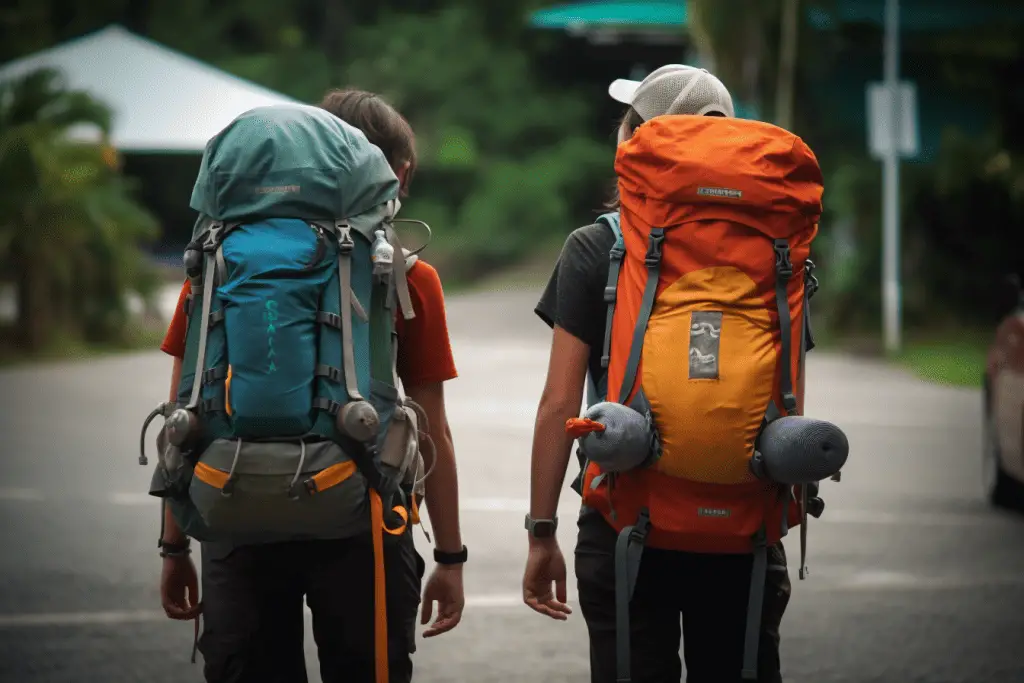Section hiking isn’t talked about as much as thru hiking but it doesn’t mean that people aren’t doing it. Even experienced thru hikers will often go section hiking from time to time. But what is section hiking?
Section hiking is a way of hiking a long-distance trail in smaller, more manageable sections over time, rather than attempting to hike the entire trail in one continuous journey. It allows hikers to experience the trail at their own pace and schedule, and can be a great way to fit hiking into a busy lifestyle.

Understanding Section Hiking: The Basics
In the simplest terms, section hiking is the practice of hiking a long-distance trail in sections, instead of doing the entire trail in one continuous journey. You can think of it as breaking a marathon into several smaller runs, each completed at your own pace and on your own schedule.
Why do people choose section hiking over thru-hiking (the term for completing a long trail in one go)? There are a variety of reasons! Maybe life’s responsibilities don’t allow for several uninterrupted months on the trail, or maybe the idea of a massive, months-long hike feels a bit overwhelming. Section hiking allows you to experience the beauty and challenge of long-distance hiking, without having to put your entire life on hold.
It’s also about flexibility. With section hiking, you can choose the time of year for each section to get the best weather or avoid crowded times. Plus, it lets you ‘test the waters’ of the hiking world without the commitment of a thru-hike. Not to mention the ability to truly savor and explore each section of the trail.
So, if you love the idea of connecting with nature, getting some good physical exercise, and challenging yourself, but can’t (or don’t want to) take off months at a time, section hiking might be just the ticket!
Section Hiking vs Thru-Hiking: The Great Outdoors Debate
To better appreciate the art of section hiking, it helps to understand how it contrasts with its ‘sibling’ activity, thru-hiking. Thru-hiking is all about completing a long-distance trail from start to end in one go. It’s a single, continuous journey, usually spanning several months, from the Appalachian Trail to the Pacific Crest Trail.
Thru Hiking
Let’s imagine you’re a thru-hiker. You’ve got to pack light, move relatively quickly, and you’re going to be away from home for a while. Plus, the demands of thru-hiking, both physically and mentally, are significant. You might face unpredictable weather, injury, or even just the challenge of maintaining your motivation over a long period of time. This doesn’t mean that there aren’t benefits to thru hiking.
Here is a short list of some of the benefits you can get from thru hiking.
- Adventure and Exploration: Thru-hiking allows you to explore diverse landscapes, ecosystems, and sometimes even cultures if the trail spans different regions or countries.
- Physical Fitness: Thru-hiking is an intense physical endeavor that promotes cardiovascular health, builds muscle strength, and improves endurance.
- Mental Strength: The physical and mental challenges you face while thru-hiking can help build resilience, adaptability, and problem-solving skills.
- Simplicity and Minimalism: Living out of a backpack for months at a time encourages a minimalist lifestyle and helps you appreciate the essentials in life.
- Disconnecting from Daily Routine: Thru-hiking is a chance to disconnect from the hustle and bustle of everyday life and immerse yourself in nature.
- Building Camaraderie: You’re likely to form strong bonds with fellow hikers you meet along the trail, as you share the unique experiences and challenges of thru-hiking.
- Developing Outdoor Skills: A thru-hike can greatly enhance your navigation, camping, cooking, and survival skills.
- Personal Growth: The journey provides an opportunity for self-discovery and introspection, which often leads to personal growth and increased self-confidence.
- Sense of Achievement: Successfully completing a thru-hike is a significant accomplishment that can provide a strong sense of achievement and fulfillment.
- Environmental Awareness: Spending prolonged time in nature can deepen your appreciation for the environment and promote a stronger commitment to conservation.
Section Hiking
Section hiking, on the other hand, is like a ‘choose your own adventure’ approach. You get to hike a long trail, but instead of going all-in, you break it down into more manageable, individual trips. This flexibility allows you to schedule your hikes for the most favorable weather, or to avoid busy periods on the trail. Plus, if you’re juggling other responsibilities, you can still keep the rest of your life on track while hiking.
Here are some advantages of section hiking:
- Flexibility: With section hiking, you can tailor your hiking plans to fit your schedule, allowing for more flexibility in terms of time and commitment.
- Variety: You can choose different sections to hike at different times, giving you the opportunity to experience a variety of terrains and seasons.
- Ease of Preparation: You have time to prepare and plan between each section, allowing for better organization and less stress.
- Less Physical Strain: Section hiking can be less demanding on the body as it allows for recovery periods between hikes.
- Balanced Lifestyle: You can maintain your career, family responsibilities, and other aspects of your life while also pursuing your passion for hiking.
- Gradual Skill Building: Section hiking allows you to gradually build your outdoor skills, physical fitness, and hiking experience over time.
- Reduced Costs: Instead of needing to fund several months of continuous hiking, you can spread the costs of gear, food, and travel over longer periods.
- Easier Resupply: Since you’re not on the trail for long stretches of time, you don’t need to worry as much about resupplying food and other essentials.
- Time to Reflect: Between each section, you have time to reflect on your experiences and what you’ve learned, enriching the overall experience.
- Accommodating Health Needs: If you have certain health conditions, section hiking can provide a safer and more manageable way to enjoy long-distance trails.
Should Your Section Hike or Thru Hike?
Both section hiking and thru-hiking have their own unique challenges and rewards. Whether you lean towards the continuous commitment of thru-hiking or the flexibility of section hiking, both give you the chance to experience the natural world, push your physical limits, and savor the quiet thrill of the trail. It all boils down to your personal preferences, lifestyle, and what you want to get out of the experience.
Planning Your Section Hike: Steps and Tips
Ready to set foot on the trail? Hold up! A successful section hike requires some thoughtful planning. Here are some steps and tips to ensure your hiking adventure is as enjoyable and safe as possible.
First off, decide on the trail you want to hike. Take into account the trail’s length, difficulty, and your personal fitness level. Remember, there’s no harm in starting small and working your way up!
Next, plan out your sections. This can be done based on distance, topography, or even specific points of interest. Ideally, each section should start and end at accessible points for easy transportation.
Now, here’s where weather comes into play. Different parts of the trail might have different ideal hiking seasons due to their altitude, latitude, or local weather patterns. Some sections might be lovely in spring, while others are best experienced in fall. So, research the best times to hike each section and plan accordingly. This way, you’ll be able to enjoy the beauty of each section in the most favorable conditions.

It’s also essential to plan your logistics. Consider transportation to and from the trail, lodging or camping arrangements if necessary, food and water supply, and any permit requirements. Remember, it’s crucial to check and abide by all trail regulations.
Don’t forget to inform someone about your hiking plans. Always let someone know where you’re going and when you expect to be back. This is a simple safety measure that shouldn’t be overlooked.
And finally, pack wisely. Essential items usually include navigation tools, first aid supplies, food and water, shelter (if you’re planning overnight hikes), and appropriate clothing. Keep in mind that the weather can change unexpectedly, so it’s best to be prepared.
Proper planning might take some time, but it’s worth the effort. Remember, the goal is to enjoy your section hike, and a well-laid plan will go a long way in making your experience safe and enjoyable.
Common Section Hiking Trails: From the Appalachian to the Pacific Crest
You’re sold on section hiking, but where should you start? Luckily, there are countless trails around the world that are perfect for section hikers. Let’s focus on two of the most iconic in the United States: the Appalachian Trail and the Pacific Crest Trail.
Section Hiking the AT
Starting on the East Coast, the Appalachian Trail spans a whopping 2,190 miles from Georgia to Maine. It crosses through 14 states, each offering a unique hiking experience. While this is a very popular thru hiking trail, you can section hike portions of this trail to take in the stunning Smoky Mountains, tread the rocky paths of Pennsylvania, or conquer the challenging terrains of New Hampshire and Maine. Each section offers something unique, from wildlife and wildflowers to history and panoramic views.
Section Hiking the PCT
Now, if we head to the West Coast, we have the legendary Pacific Crest Trail. Stretching about 2,650 miles from the Mexican border to the Canadian border, this trail takes hikers through some of the most diverse landscapes in the country. You can choose to hike sections passing through the scorching deserts of Southern California, the breathtaking Sierra Nevada, or the volcanic peaks of the Cascade Range in the Pacific Northwest. There’s truly a section for everyone!
Both of these trails offer an array of section hiking opportunities, whether you’re after a leisurely hike or a more strenuous adventure. But remember, these are just two examples. There are countless trails across the country and around the world, all offering unique experiences for section hikers. Do your research, find the one that resonates with you, and start planning your section hiking adventure!
Wrapping Up the Trail: The Joy of Section Hiking
So, we’ve embarked on a journey to answer the question: “What is section hiking?” From understanding the basics to exploring renowned trails like the Appalachian and Pacific Crest, we’ve covered some significant ground. And whether you’re an avid hiker or a newbie to the trail, we hope this post shed light on why section hiking could be your next big adventure.
Section hiking is more than just a physical activity—it’s an opportunity to connect with nature, challenge yourself, and create unforgettable memories, all at your own pace. Whether you’re in it for the exercise, the scenic views, or the sense of accomplishment, remember to embrace the journey as much as the destination. Now it’s your turn to lace up those hiking boots and set out on your own section hiking adventure.
